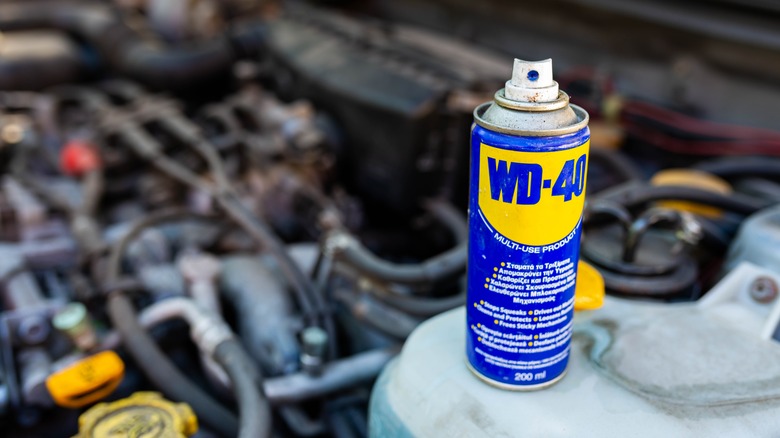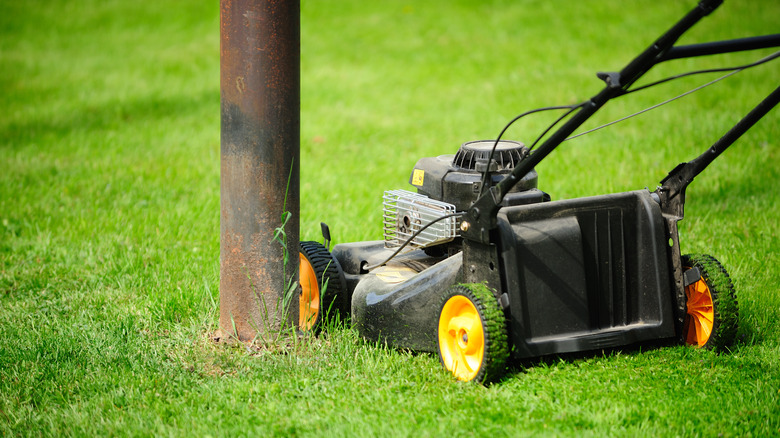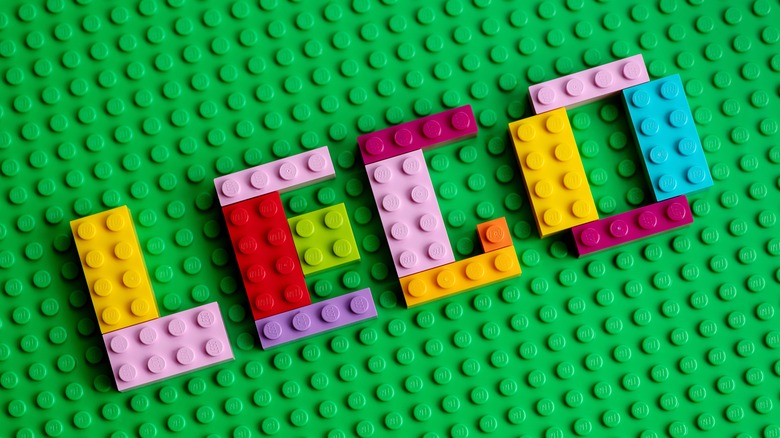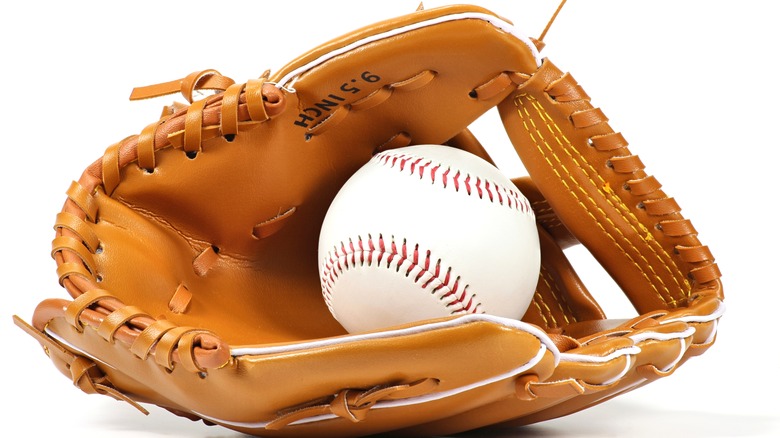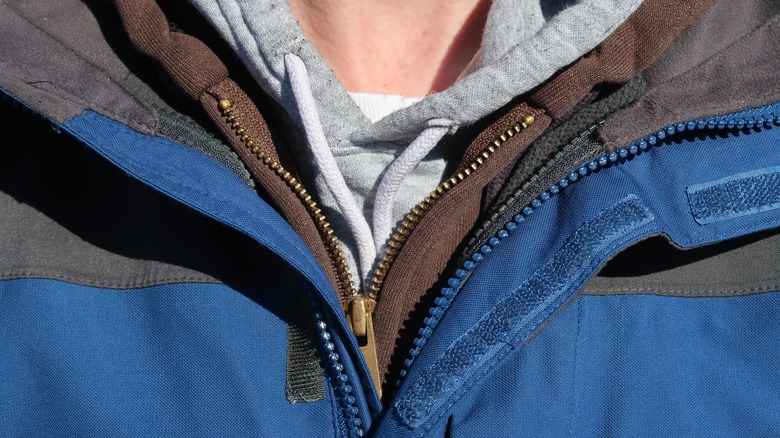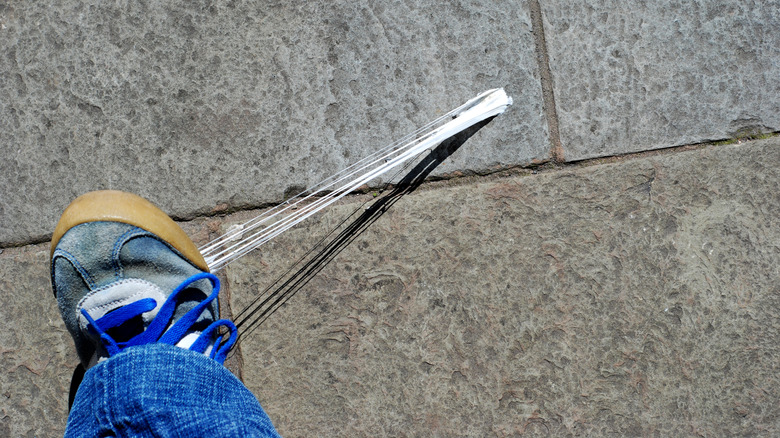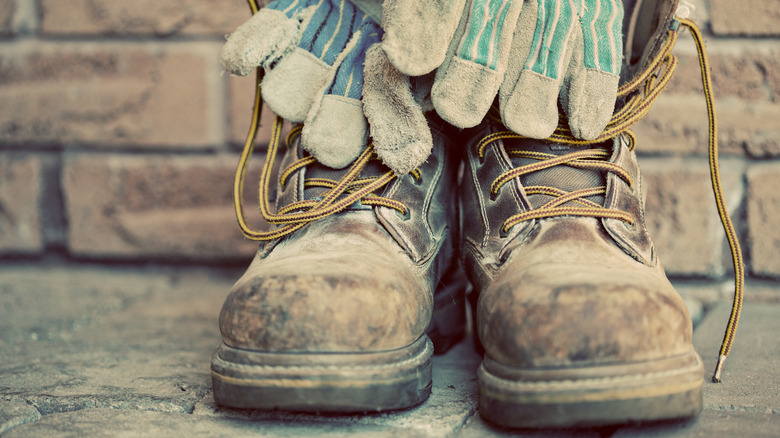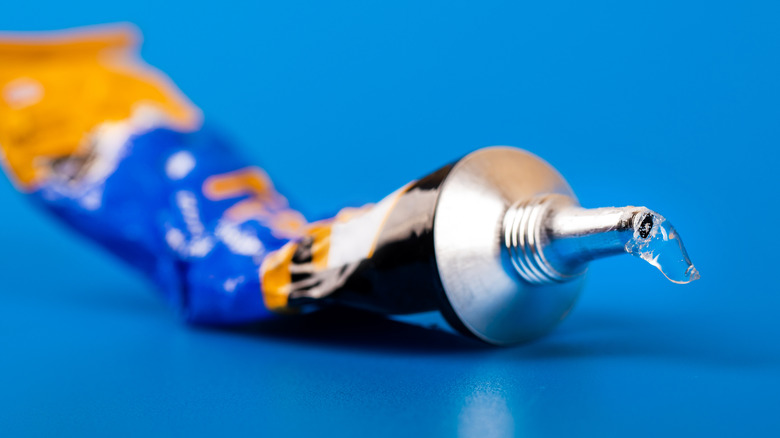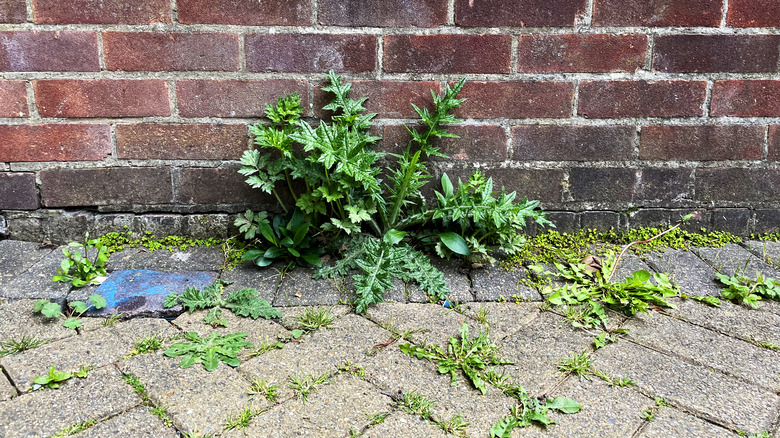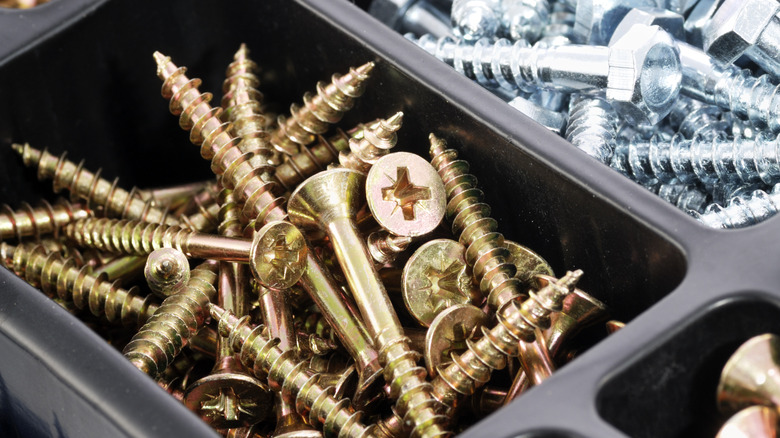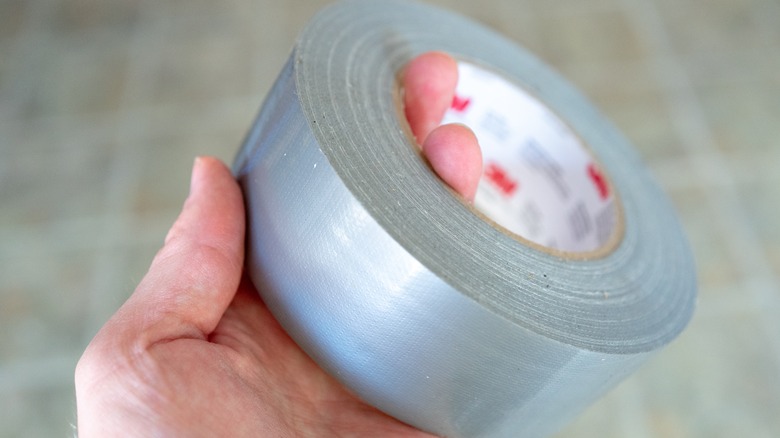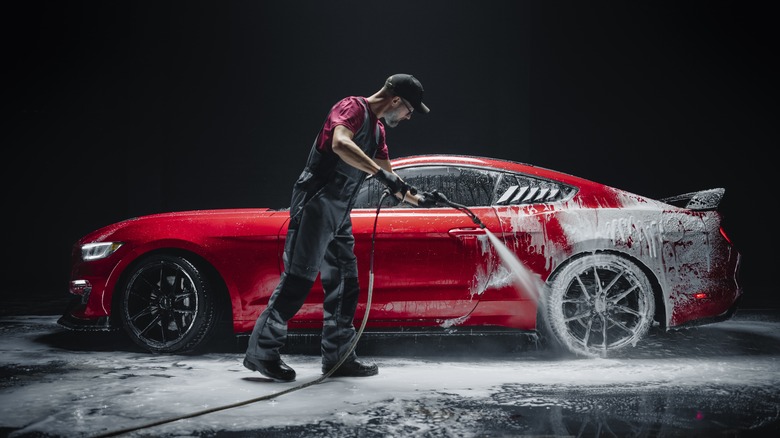12 WD-40 Hacks You'll Wish You Knew Sooner
We may receive a commission on purchases made from links.
WD-40 is a household name found in almost every garage. The product was launched in 1958 by a company called Rocket Chemical Company, which was trying to figure out a formula for a rust-prevention solvent for use in the aerospace industry. While it took the group 40 attempts to get the formula right, they finally did, and it's the same formula that's still used today. Add in the Water Displacement acronym, and that's how we got to WD-40.
Today, WD-40 is still used for its original purpose, which is rust prevention and lubrication. Millions of people have used it to stop a door hinge from squeaking to loosen nuts and bolts in a car that have been tightened up too far. It's been a popular product for years, and according to WD-40's history webpage, four out of five households and 81% of professionals in 1991 either regularly used or had a can of the stuff ready and waiting. In the years since its launch, the brand has created and released multiple products for varying uses, but the original WD-40 remains the king of the product lineup.
As it turns out, part of the reason it's still so popular after all these years is because it has so many other uses. From cleaning things to unsticking non-mechanical items, this little water displacement solvent can help you in a variety of ways other than keeping things from squeaking. Here are some unique uses for WD-40.
Keep dirt, snow, and plants from sticking to your tools
A great use for WD-40 is to spray it on your yard implements to keep them clean. In fact, the company itself suggests this useful tip.
Simply spray your lawnmower blades with WD-40 before you mow the lawn, and you'll find that grass doesn't build up on them. This also works for shears, clippers, and other lawn and garden implements that might wind up with grass, trees, and bush debris build-up. In addition to making cleanup easier, it'll also help prevent staining, corrosion, and other wear that comes along with such activities.
In addition, WD-40 says that this nifty trick works on shovels in both the snow and dirt as well. It's the same general principle — simply spray your shovel with WD-40 and the dirt or snow will slide right off instead of building up as you dig. That means you'll spend less time cleaning the shovel you used in the dirt, and you won't have to stop every few minutes to knock the snow off of your snow shovel. Like the pruning shears and lawnmower blades, this can also help prevent corrosion and wear, which potentially helps your tools last longer.
Unstick LEGO blocks
Unsticking LEGOs is another well-known use for WD-40. Anyone who's played or built with LEGOs knows how this happens — you put two blocks of the same width and length together and then it's impossible to get them apart. The smaller the blocks, the more difficult it is. WD-40 is a good solution to this problem. According to the company, you use the straw attachment to shoot some WD-40 into the crack between the two blocks to work in some of the liquid. The blocks should then pry apart. Rinse them off, let them dry, and you're back in business.
Now, with that said, there is a limit here. The WD-40 can be harmful to some types of blocks, particularly ones with painted-on or sticker decals. So, we might not recommend using WD-40 to unstick the head off of a LEGO torso or to unstick any specialized or limited-edition pieces. After all, we're going to talk about sticker residue later, so it's something that WD-40 is known for. When using this trick, we recommend keeping it strictly to your normal, every day blocks, and everything should be okay.
Break in baseball gloves
Baseball gloves are notoriously stiff when they roll off the production line, so it's apropos to break in the glove to loosen it up so that it's more effective during play. As it turns out, WD-40 is one of the many chemicals that people use to break in baseball gloves.
According to WD-40's website, the method involves spraying the entire outside of the glove with WD-40 so that it's thoroughly covered. Then wrap it in rubber bands and leave it overnight. The next day, the glove will have loosened up. It won't recreate the comfort of a well-worn glove in one day, but you'll have enough flexibility in the glove to actually use it.
Given baseball's long history, there are dozens, if not hundreds, of methods to break in a baseball glove, which includes anything from shaving cream to your home oven. We only recommend solutions like WD-40 for the first night to get that new glove stiffness to wear down a bit. However, after that, the best way to break in a baseball glove is to play with it so that it forms better on your hands. After all, that's what the pros do.
Unstick zippers
Let's go back to the basics a bit. WD-40 is best known for its lubrication properties since it is essentially a mix of lubricants and other ingredients. One good use for those lubricants is zippers. Hoodies, jackets, luggage, pants, dresses, and essentially any other item that has a zipper can benefit from a little spritz of WD-40. When the zipper gets stuck, very carefully spritz the zipper and it should free itself from whatever tangle it got itself caught in. Zippers are just metal, so it's right in WD-40's wheelhouse.
The key here, though, is to be careful. WD-40 can stain some types of fabric, particularly polyester. It's not the end of the world and it'll come out with the proper care. The conventional wisdom for WD-40 stains is simply dish soap, lots of scrubbing, and patience. The irony is that WD-40 is useful for removing grease stains from clothes, and then you use dish soap to remove the WD-40 afterward. So, there are procedures in place in case you overspray your zipper and hit your clothes in the process. Plus, you just got a bonus tip about WD-40 being good for grease stain removal. We aim to please.
Removing Crayon marks from the wall
Parents know that this sort of thing happens fairly often. The kids get ahold of the Crayons — maybe you have to take a phone call, and they're left unattended for a minute or two. The result is a colorful mosaic of childhood artwork on your walls. WD-40 can fix this problem. According to the company, you spray the Crayon marks on the wall and give the solution a few minutes to do its thing. Then, you just wipe it off. It may require a bit of elbow grease, but it'll still come off much easier than if you just use water.
There are a variety of things that WD-40 will clean off of your wall. Fortunately, wallpaper and paint aren't considered among of them. That makes it fairly safe to use on your walls without worry of harm. With that said, make sure to test it on a small area just to be sure. However, we do recommend only leaving it on there for a couple of minutes because it can stain if left there for a long time. If the smell bothers you, come behind the WD-40 with some basic dish soap and warm water to clean that up as well.
Removing gum from carpet and shoes
Unwanted gum is another substance that can be taken care of with WD-40. More specifically, gum that is stuck to things like shoes, clothing, carpet, and other such items. It works similarly to the Crayons on the wall. WD-40 recommends that you use the straw attachment for this one to ensure that you get the spray above, to the sides, and underneath the gum if at all possible. Then, you wait for a little while, and the gum should come off much easier. Repeat the process with any remnants. It's important to get both the top and bottom of the gum — otherwise, it might take multiple tries.
In this instance, the better product is the WD-40 Multi-Use spray over the traditional WD-40. Also, since we are talking about fabrics here, it is a responsible idea to test on an inconspicuous space to ensure that nothing untoward will happen to your garments or carpet. There are also plenty of ways to get WD-40 out of your carpet once the gum is gone so no long-term harm is done. If you do have some leftover gum, you can scrape it and use a regular carpet cleaner to get things looking the way they once did.
Waterproofing your work boots
WD-40 is a tool for a lot of professionals, but it's not just great at lubricating machine parts. You can also use it to clean, condition, and protect your work boots. Before doing anything, the company recommends thoroughly cleaning the gunk off of your boots. WD-40 can do a lot of things, but bristled brushes are quicker and more efficient. Once cleaned off, you can spray the boots with WD-40 to introduce a bit of waterproofing that works in snow, rain, and moderately wet conditions. For this, the company recommends the WD-40 Specialist Silicone spray for this application over the multi-use spray or the traditional formula.
This won't work with all types of work boot materials. Leather is the obvious choice, as WD-40 is safe for leather. After all, it works for baseball gloves. However, most fabrics will react the same way as any other fabrics where it'll likely stain if it's left on there too long. The stains are cleanable, but the fabric won't become waterproof with this method. You'll need a different product for that. That said, most work boots are leather anyway so this may not be an issue.
Remove superglue from hard surfaces (and you)
Cleaning up superglue is a great use for WD-40. The stuff is hard to remove as is, but WD-40 Multi-Use can clean it up pretty well. The company recommends that you use it nearly the same way as you would Crayons or gum. Spray the superglue thoroughly with the product, wait a few minutes, and then wipe it up with a cloth. Repeat the process if necessary. While there are some warnings about using WD-40 on some surfaces, wood is not one of them, so you can use this freely on your workbench if that's where the superglue accident happened.
This also works on your skin and much the same way. You can spray WD-40 on your hands to remove superglue. It works by penetrating the adhesive and then lifting it off of the surface. According to some, it even works on glass. Of course, it's not the only product that works. As it turns out acetone and rubbing alcohol can also remove superglue from surfaces. Since those are also both common household items, you now have at least three good ways to remove superglue from surfaces.
Kill weeds between the cracks in your sidewalk
So far, we've discussed how WD-40 makes things move when they aren't and cleaning things up. As it turns out, it's also a fairly potent and reliable weed killer. Simply spray the stuff on weeds, and they die in relatively short order. WD-40 recommends using the straw attachment for this so you can be sure to only hit the weeds you're aiming for. Overdoing it doesn't yield better results. You simply need to coat the plant in the spray to get the job done.
This is another exercise in self-control as well. WD-40 will kill any plant you spray it on, including grass, plants in your garden, and any other plant life that you actually want on your property. Thus, we only recommend this for small, specific use cases. There are better products out there to deal with tons of weed growth, especially in lawns where you only want to kill some of the plants.
Let's face facts: spraying an entire yard with WD-40 would be silly. Not only would that be expensive, but you'd kill the whole lawn. However, it works great for sidewalk cracks and similar use cases.
Prevent most metals from rusting or tarnishing
The WD in WD-40 stands for water displacement, and that's one of the things the product is best at. One such use case for it is protecting metals of various types from getting rusty or corroded over time. WD-40 recommends spraying down a box of nails or screws, for example, and those nails and screws will remain free from the effects of moisture for a long time. It doesn't take a lot and you don't have to soak them — just a light coating will get the job done.
As it turns out, this can also work with jewelry. WD-40 recommends cleaning and polishing the jewelry with regular products designed for that very purpose, so this isn't another case of using WD-40 to clean something. That said, if you don't intend to wear a piece of jewelry for a long time, you can gently wipe a layer of WD-40 on it, which will help keep it shiny and tarnish-free while it sits in storage. WD-40 is safe to use on gold and won't cause any long-term harm to jewelry made out of gold. Oxygen and water do cause damage, though, and those are two things WD-40 can protect against.
Remove all traces of duct tape and other sticker residue
Earlier, we talked about cleaning LEGOs with duct tape but advised that you be careful not to clean any pieces with stickers on them. The reason for that is because WD-40 is known for removing sticker residue. Generally, it works about the same way as it does with superglue. You spray WD-40 on the affected area, let it sit for a bit, and then wipe it up with a cloth. WD-40 reacts with the adhesive the same way it does with superglue, which makes it relatively easy to lift off of surfaces.
According to WD-40's website, you can take care of a lot of different sticky substances with the product. You can even use it on stickers that you haven't tried to remove yet. The WD-40 will seep into the sticker and take out the adhesive anyway. That's why you don't want to use it on LEGO pieces with stickers.
In any case, the next time you have an item and you want to remove the sticker, you can use a spritz of WD-40 to get the job done. A good use for this is Christmas presents with stubborn price tags that you don't want your loved ones to see.
Clean various parts of your car
We've talked at length about the cleaning power of WD-40, along with its lubrication properties in terms of dirt, snow, and rain. You can apply all these same principles to your car. It'll clean bugs out of your grill and help prevent them from building up again. It's safe to use on car paint, which means that you can use it to remove things like bird droppings, tree sap, and any other such foreign gunk. We don't recommend dousing your entire car with the stuff, but for spot-cleaning specific parts, it's a great tool.
Perhaps one of the most interesting uses of WD-40 is using it to clean your headlights and taillights. WD-40 has been known to restore the clarity of plastic headlight covers and remove any cloudiness. To do this, clean off the headlights of any surface dirt, spray it with WD-40, let it sit for a few minutes, and then buff it out with a towel, using side-to-side motions — not circular motions. Then, wash the remainder off with soap and water. We also recommend a couple of drops of carnauba wax for additional UV protection after you're done cleaning. It'll help delay yellowing and cloudiness in the future.
